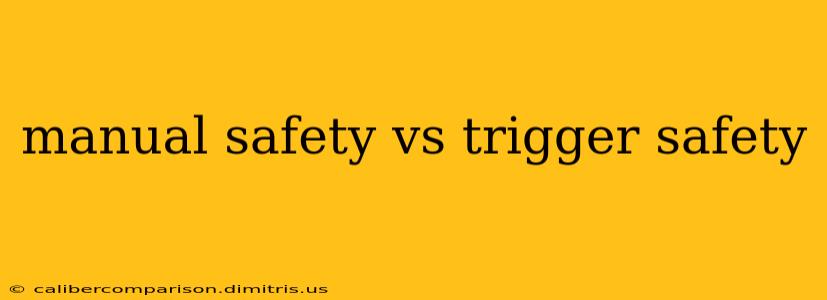Choosing a firearm involves many considerations, and understanding the different safety mechanisms is paramount. Two key safety features often debated are manual safeties and trigger safeties. This in-depth guide explores the nuances of each, helping you make informed decisions based on your individual needs and preferences.
What is a Manual Safety?
A manual safety is a physical lever or switch that, when engaged, mechanically blocks the firearm's firing mechanism. This prevents the gun from firing, even if the trigger is pulled. Manual safeties are typically found on the frame of the pistol or the receiver of a long gun. They can be located in various positions, depending on the firearm's design. Common positions include:
- Thumb safety: Located on the frame, typically operated by the thumb.
- Cross-bolt safety: Located behind the trigger guard, often operated by the trigger finger.
- Slide safety: Integrated into the slide itself, engaging automatically when the slide is closed.
Advantages of Manual Safeties:
- Positive engagement: Provides a clear visual and tactile indication that the firearm is safe.
- Reliable: Mechanically simple and generally reliable when properly maintained.
- Familiar design: Widely used and understood by many firearm owners.
Disadvantages of Manual Safeties:
- Requires extra step: Adds an extra step to the process of drawing and firing the weapon, potentially slowing reaction time in a self-defense situation.
- Potential for user error: Can be accidentally disengaged, requiring careful attention to detail.
- Possible malfunction: Although rare, mechanical failures are possible.
What is a Trigger Safety?
A trigger safety is an internal mechanism integrated into the trigger itself. It prevents the gun from firing unless the trigger is fully depressed and the safety mechanism is disengaged. Trigger safeties are often internal and invisible to the user. Different types exist, including:
- Drop safety: Prevents the gun from firing if dropped.
- Internal firing pin block: Prevents the firing pin from striking the primer, even if the trigger is pulled.
Advantages of Trigger Safeties:
- Passive safety: Always active unless the trigger is fully depressed correctly.
- No extra step: Doesn't require manual manipulation for engagement, speeding up the draw and firing process.
- Often combined with other safeties: Frequently found in conjunction with other safety mechanisms, providing layered protection.
Disadvantages of Trigger Safeties:
- Less visible: Provides no visual confirmation of engagement; reliance is on the mechanism's integrity.
- Potential for malfunction: While less common than manual safety issues, malfunctions are possible.
- Not a substitute for training: Trigger safeties alone do not replace the importance of proper firearm handling and training.
Manual Safety vs. Trigger Safety: The Verdict
There's no single "best" safety mechanism. The ideal choice depends on individual preferences, shooting style, and the intended use of the firearm. Many modern firearms incorporate both manual and trigger safeties, offering a layered approach to safety.
Consider these factors when making your decision:
- Your experience level: Beginners might benefit from the visible confirmation of a manual safety.
- Intended use: For concealed carry, a faster draw may favor a trigger safety or a firearm with a less obtrusive manual safety.
- Personal preference: Ultimately, the most important factor is choosing a system you're comfortable and confident using.
Beyond the Safety Mechanisms: Responsible Gun Ownership
Regardless of the type of safety mechanism your firearm employs, responsible gun ownership practices are crucial. This includes:
- Thorough training: Proper firearm handling and safety training are essential.
- Regular maintenance: Keep your firearm clean and properly maintained to ensure all safety mechanisms function correctly.
- Safe storage: Store your firearm securely and out of reach of unauthorized individuals.
Choosing between manual and trigger safeties is a personal decision. Understanding the pros and cons of each will help you make an informed choice that aligns with your needs and enhances your firearm safety. Remember, safety is paramount, and no safety mechanism can replace responsible gun ownership practices.

